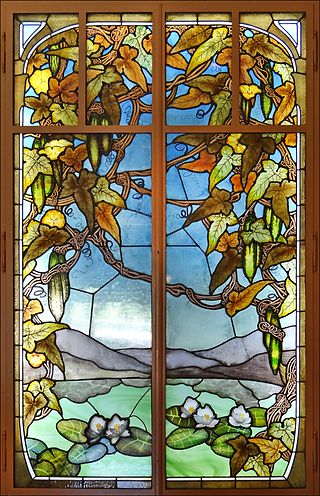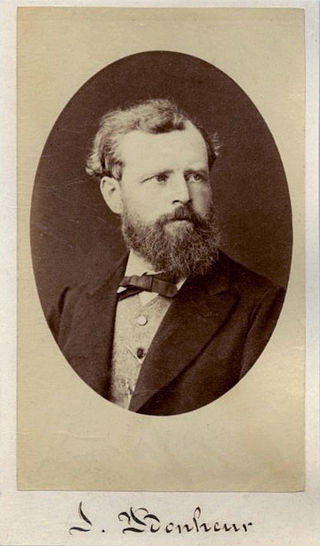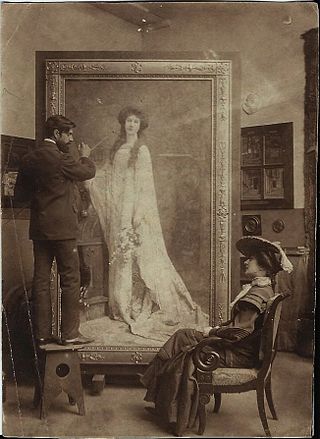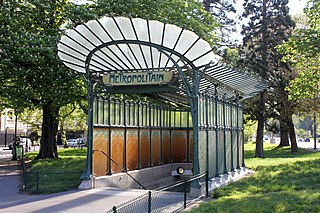
François Auguste René Rodin was a French sculptor generally considered the founder of modern sculpture. He was schooled traditionally and took a craftsman-like approach to his work. Rodin possessed a unique ability to model a complex, turbulent, and deeply pocketed surface in clay. He is known for such sculptures as The Thinker, Monument to Balzac, The Kiss, The Burghers of Calais, and The Gates of Hell.

Art Nouveau is an international style of art, architecture, and applied art, especially the decorative arts. It was often inspired by natural forms such as the sinuous curves of plants and flowers. Other characteristics of Art Nouveau were a sense of dynamism and movement, often given by asymmetry or whiplash lines, and the use of modern materials, particularly iron, glass, ceramics and later concrete, to create unusual forms and larger open spaces. It was popular between 1890 and 1910 during the Belle Époque period, and was a reaction against the academicism, eclecticism and historicism of 19th century architecture and decorative art.

The Exposition Universelle of 1900, better known in English as the 1900 Paris Exposition, was a world's fair held in Paris, France, from 14 April to 12 November 1900, to celebrate the achievements of the past century and to accelerate development into the next. It was the sixth of ten major expositions held in the city between 1855 and 1937. It was held at the esplanade of Les Invalides, the Champ de Mars, the Trocadéro and at the banks of the Seine between them, with an additional section in the Bois de Vincennes, and it was visited by more than fifty million people. Many international congresses and other events were held within the framework of the exposition, including the 1900 Summer Olympics.
Guy Hain is a French art forger who produced number of fake bronze sculptures.

Jean Alexandre Joseph Falguière was a French sculptor and painter.

The Battle of Villiers, also called the Battle of Champigny, was the largest of the French sorties from besieged Paris during the Franco-Prussian War.

Bry-sur-Marne is a commune in the Val-de-Marne department in the eastern suburbs of Paris, France. It is located 12.6 km (7.8 mi) from the center of Paris.
Pierre-Jules Mêne was a French sculptor and animalier. He is considered one of the pioneers of animal sculpture in the nineteenth century.

Pierre Félix Masseau, known professionally as Fix-Masseau. He was a noted French sculptor and father of poster artist Pierre Fix-Masseau with whom he is sometimes confused with.

Alexandre Bigot was a French ceramicist. He was primarily a ceramics manufacturer, producing the designs of many artists and architects of the French Art Nouveau movement, including: Jules Lavirotte, Hector Guimard, Louis Majorelle, Henri Sauvage, Henry van de Velde, Auguste Perret, Andre Arfvidson, Anatole de Baudot and more.

École de Nancy, or the Nancy School, was a group of Art Nouveau artisans and designers working in Nancy, France between 1890 and 1914. Major figures included the furniture designer Louis Majorelle, ebonist and glass artist Jacques Grüber, the glass and furniture designer Émile Gallé, and the crystal manufactory of Daum. Their work was largely inspired by floral and vegetal forms found in the region. The goal of the group was to produce in series ordinary objects, such as furniture, glassware, and pottery, with fine craftsmanship and in original forms, making art objects available for people's homes.

Isidore Jules Bonheur, best known as one of the 19th century's most distinguished French animalier sculptors. Bonheur began his career as an artist working with his elder sister Rosa Bonheur in the studio of their father, drawing instructor Raymond Bonheur. Initially working as a painter, Isidore Jules Bonheur made his Salon debut in 1848.

Jules Marie Auguste Leroux was a French painter and illustrator.
Élisabeth Cibot is a French sculptor and art historian.
Paul-Édouard Delabrièrre was a French animalier sculptor who worked in the mid-to-late 19th century and the early 20th century. He had 70 of his sculptures juried into the prestigious Salon art exhibition held annually in Paris. His monumental work called L'Equitation adorns the facade of the Louvre.
Julius Paul Schmidt-Felling (1835–1920) was a German sculptor who worked during the mid-to-late 19th century and early 20th century. The subject matter of his work was wide and varied. He produced, among others, bronze statues of heroic warriors, athletes, blacksmiths, and farmers. A number of his sculptures of young children were in the Dutch colonial style, some being whimsical in nature.

Otto Schmidt-Hofer (1873–1925) was a German sculptor who worked during the late 19th century and early 20th century. His work was primarily Neoclassical and Art Nouveau between 1893-1914 and Art Deco from 1915 until his death in 1925.

Animalier school or animalier art was a late-18th and 19th-century artistic genre and school of artists who focused on depictions of animals. The movement was largely centered in France, with some artists producing related subject matter in England, Italy, Germany, Russia, and North America.

The Art Nouveau movement of architecture and design flourished in Paris from about 1895 to 1914, reaching its high point at the 1900 Paris International Exposition. with the Art Nouveau metro stations designed by Hector Guimard. It was characterized by a rejection of historicism and traditional architectural forms, and a flamboyant use of floral and vegetal designs, sinuous curving lines such as the whiplash line, and asymmetry. It was most prominent in architecture, appearing in department stores, apartment buildings, and churches; and in the decorative arts, particularly glassware, furniture, and jewelry. Besides Guimard, major artists included René Lalique in glassware, Louis Majorelle in furniture, and Alphonse Mucha in graphic arts, It spread quickly to other countries, but lost favor after 1910 and came to an end with the First World War.

Auguste Prévot-Valéri, pseudonym of Valéri Prévost, was a French painter known for pastoral landscapes. He was the father and teacher of the landscape painter André Prévot-Valéri (1890-1957).














